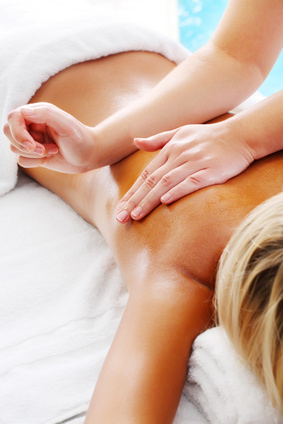What is deep tissue massage?

Deep tissue massage is a more intense, prolonged treatment than the regular treatments performed within spas and beauty clinics which focus on relaxing the body through the use of gentler massage and aromatherapy oils.
A more intensive, forceful treatment, this type of massage is ideal for those who have scar tissue, have experienced some kind of injury including whiplash or Repetitive Strain Injury; or suffer from postural problems or muscle spasms in addition to other specific painful conditions. It is also designed specifically to alleviate chronic muscle tension experienced in particular by athletes, those with physically demanding jobs and people suffering from:
- Chronic pain
- Limited mobility
- Ostearthritis
- Fibromyalgia
When muscles are used extensively, they become stressed. Oxygen and nutrients are not able to be circulated effectively around the body and so toxins begin to build up in the tissue, causing the muscles to tense and ache.
By using slow strokes and deep finger pressure on the contracted areas, either following or moving across the grain of the muscles, the tendons, connecting tissue (known as the fascia) and the muscles themselves will begin to loosen up as the toxins are once more released and blood flow and oxygen can begin to circulate.
Similar in technique to a Swedish massage, deep tissue massage usually focuses on a number of small, specific areas of tension.
What to expect
A full deep tissue massage should take just over an hour for the first session, with subsequent treatments taking around an hour each time. This is longer than most other massage sessions but this is so that enough time is taken for the toxins in the muscles to be released and for the muscles themselves to relax. The minimum number of treatments is usually three to five, given on a weekly basis.
Clients should be dressed in loose clothing to attend the appointment as they are likely to be slightly sore when leaving and so should make themselves as comfortable as possible.
Before the treatment begins, clients are advised to have a sauna or steam bath to warm up their muscles, which will make the massage all the more effective. They may also choose to have one after, too, in order to help soothe away any discomfort. It is advised too, to abstain from heavy meals and alcohol, as the vigorous manipulation of the muscles could potentially trigger a bout of nausea. A considerable amount of toxins will be released during the process however, so drinking a considerable amount of water both before and after the treatment is always a good idea.
There are some individuals for whom deep tissue massage is not advisable and the consultant should be informed if the client:
- Is pregnant
- Has a history of mental illness
- Has heart or respiratory problems
- Has skin allergies
- Has joint problems
- Has recently had surgery
- Has diabetes
Before any treatment is given, the consultant should agree on a strategic plan for the individual, detailing precisely which areas they intend to cover and how many sessions will be needed, as well as discussing preparation and self-care.
The client will normally be asked to relax on a treatment table under a towel, with only the areas which are to be worked on, being exposed. The treatment room is often dimly lit and warm, with relaxing music being played. Oils may be used during the massage to aid the consultant but unlike other massages, they are unlikely to be aromatherapy oils.
During the massage, there may be some discomfort as “knots” are worked on, particularly around the shoulder blades. The consultant may run their elbow down the length of the spine as part of the treatment and may also give the massage using their knuckles, fingers, hands, elbows and forearms.
Usually, the consultant when working on the back and spine, they will keep one hand on the lower back with the other hand working on the shoulder blades. Once he has located any knots, he will rub them firmly in a clockwise circular motion to loosen them up.
The client will not feel relaxed during the session and indeed may feel sore for several hours afterwards. They will be advised to drink lots of water to help eliminate the toxins and take a hot shower to ease their muscles. There is no reason to take time off work or to avoid driving.
The Effects & Benefits
After several hours, any muscle pain should have ceased to be replaced by a looser, more relaxed feeling. However, because the massage itself is so forceful, people with more sensitive skin may experience some bruising either below or on the surface of their skin.
The main benefits of deep tissue massage include:
- reduced muscle pain
- better posture
- reduced stress and anxiety
- better movement
- a reduction of muscle tension and spasms
- reduced scar tissue
- better blood and oxygen circulation
After a course of treatment, provided that the client consistently improves their posture and exercises sufficiently to allow oxygen to circulate freely throughout their muscles, the pain associated with muscle tension should stop or at least abate.